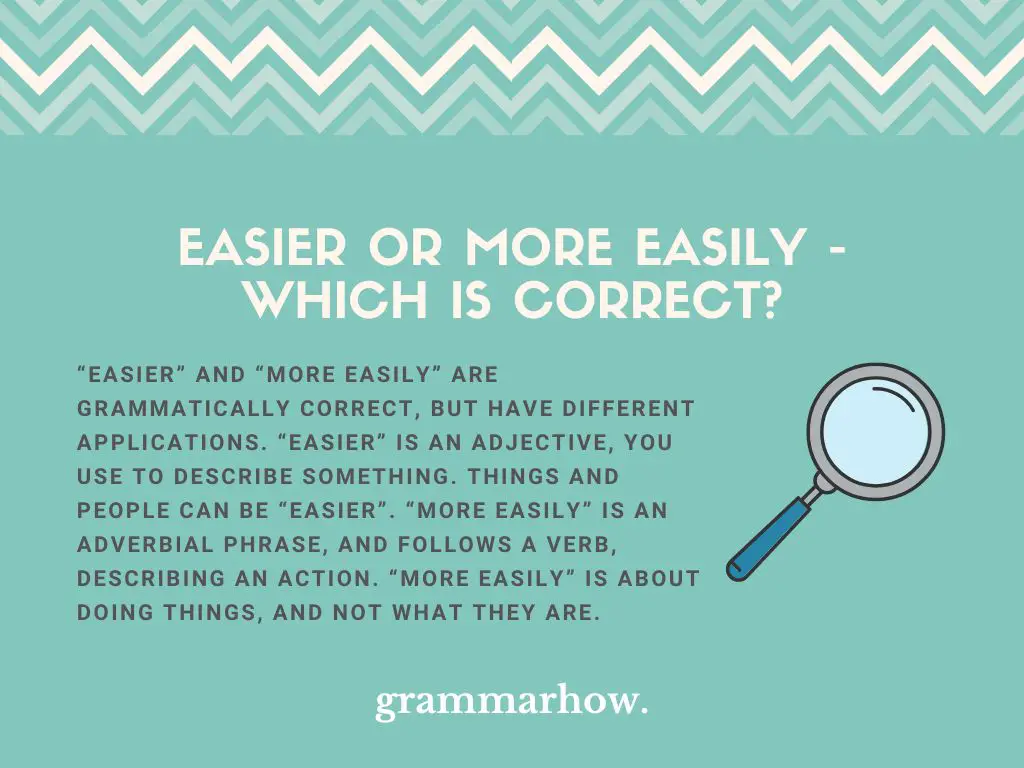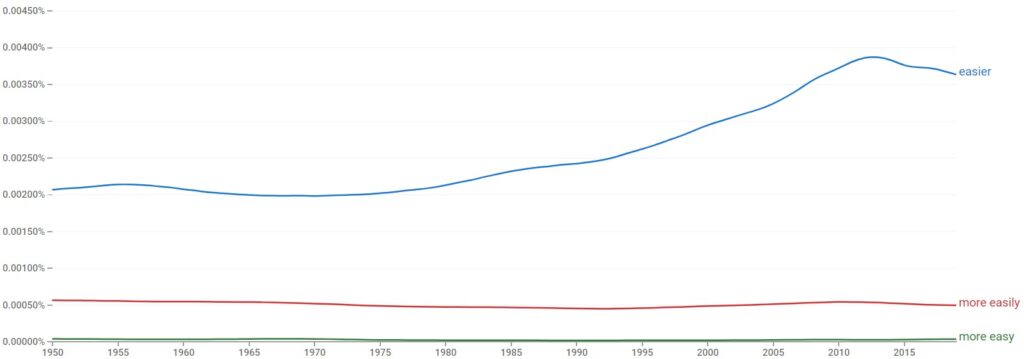What’s the best form to express that something is very easy, in fact, more than expected? Should we say “Easier” or “More Easily”?
We want to know if both forms are correct, or if one should be avoided. Also, we want to know when to use each. Let’s find out!
Easier or More Easily – Which Is Correct?
“Easier” and “More Easily” are grammatically correct, but have different applications. “Easier” is an adjective, you use to describe something. Things and people can be “Easier”. “More Easily” is an adverbial phrase, and follows a verb, describing an action. “More Easily” is about doing things, and not what they are.

Take a look at the examples, to make sense of those concepts:
- This task could be much easier if we had help.
- This task could be more easily done if we had help.
The sentence in the examples is about a task. In the first sentence, we describe the task itself and realize that it would be “Easier” if help was available. “Easier” is the adjective we used to describe the task.
In the second sentence, we talk about doing the task, and the process of accomplishing it. We say the task would be “More Easily” done if there was help. “More Easily” refers to doing the task, the action.
The meaning of both sentences isn’t so different. With the proper grammatical adjustments, it’s possible that now and then those forms could overlap in meaning and interchange. But the emphasis that each form places is different.
This is one of those nuances we should be aware of, to use in our favor when constructing our speech. When choosing between “Easier” and “More Easily” think about what you’re trying to put the spotlight on and what you’re trying to describe. Apply the correct word accordingly.
Easier
“Easier” is the comparative form of the word “Easy”, which indicates things that need little effort. “Easier” tell us that something requires even less effort than the other thing it’s being compared to. “Easier” is an adjective, that helps us describe things.
Every time you’re comparing how easy things are, you can use the word “Easier”, just like you can see in the examples below:
- Don’t you think it would be easier to get it done now?
- Carla found driving automatic vehicles easier than manual ones.
- John told me working from home is easier than going to the office every day.
- It was always easier to sleep after a cup of chamomile tea.
- Meeting at the office in the afternoon would be easier.
- How can we make the process easier for your team?
More Easily
“More Easily” is an adverbial phrase, that helps us describe actions. “Easily” means to do things in an easy manner. “More Easily”, therefore, indicates that something can be done more effortlessly if something’s changed or adjusted, or when comparing different things.
Take a look at some good examples:
- After adding the plant food, the crops will grow more easily.
- Lucy can problem solve and find her way out of sticky situations more easily than most.
- I communicate more easily with others than Paul does.
- Sounds much more easily said than done, don’t you think?
- European citizens are more easily accepted into the US than those from other areas of the world.
- Subtle changes can be done more easily than drastic ones.
More Easy
“More Easy” is an incorrect alternate form for “Easier” and “More Easily”. If you need to compare two things and mention which one is “Easier”, you don’t use “More Easy”. Similarly, if you wish to share how “Easily” something’s done, you’d say “More Easily”, and not “More Easy”.
“More Easy” is grammatically incorrect and should be avoided. Let’s take a look at some examples that include the incorrect “More Easy”, followed by a correct version of the sentence:
- This would be more easy if we had more tools. (incorrect)
- This would be easier if we had more tools.
- A new laptop would make her job a lot more easy. (incorrect)
- A new laptop would make her job a lot easier.
- The process will flow more easy if we make some minor adjustments? (incorrect)
- The process will flow more easily if we make some minor adjustments?
Which Is Used the Most?
Which one of those forms do you think is used more often, “Easier”, “More Easily”, or “More Easy”? Let’s take a look at the graph from Google Ngram Viewer below and find out.

“Easier” is by far the favorite form, according to the graph. It appears with more frequency, and we think it makes sense, considering it’s an adjective that we can all use in many different situations.
“More Easy” is at the very bottom of the graph. This is expected because this is an incorrect form we should all avoid using.
“More Easily” falls somewhere in between. It’s used relatively frequently, but not as often as “Easier”. Perhaps, the reason for it is that “More Easily” is slightly more complicated.
Keep in mind that both “Easier” and “More Easily” are correct and they have different applications. Use each accordingly.
Final Thoughts
“Easier” and “More Easily” are helpful tools to describe things, but they have different uses. “Easier”, as the comparative form of “Easy” describes things that need less effort than others. “More Easily”, as an adverbial phrase, describes actions and indicates they can be “Easier” if changes or adjustments are made.

Martin holds a Master’s degree in Finance and International Business. He has six years of experience in professional communication with clients, executives, and colleagues. Furthermore, he has teaching experience from Aarhus University. Martin has been featured as an expert in communication and teaching on Forbes and Shopify. Read more about Martin here.

